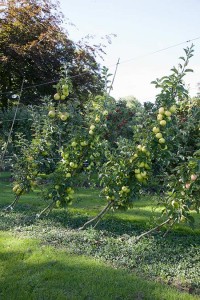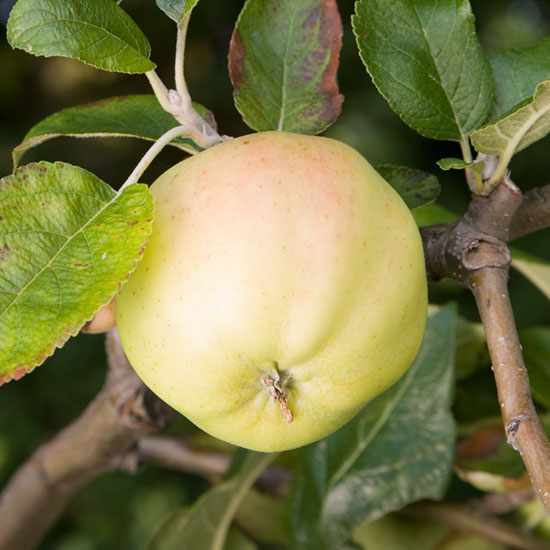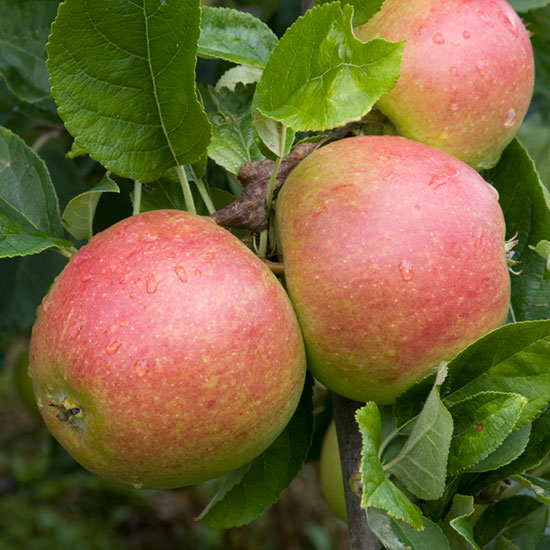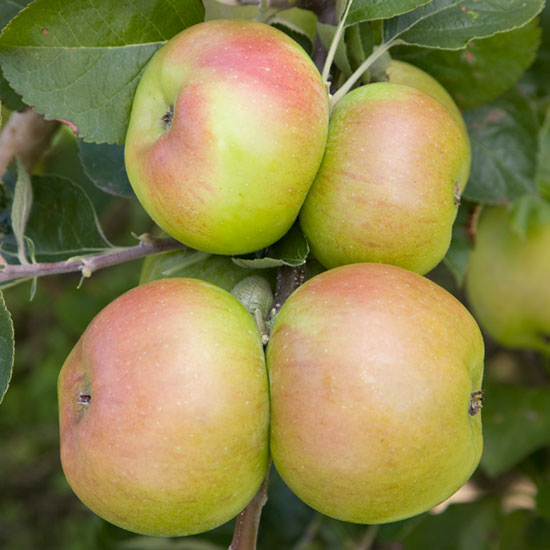Most countries have a collection of apple cultivars which they cook or eat as they see fit but the British chose to distinguish between those which adorned the tables of sumptuous dinner parties and those which finished in the kitchen for cooking purposes. This has ensured that we now have a rich vein of cooking apples which can be used for apple tarts, apple pies, baked apples etc., and those to be enjoyed especially for their unique flavour and colour.
Apples have been in cultivation in the UK for a long time – the cultivated apple as we know it – malus pumila domestica – has developed over thousands of years and no-one can be quite certain how it originally spread throughout the country. But due to accidental seedlings and deliberate hybridisations thousands of cultivars have been developed and we are fortunate indeed to have such a large number to consider.
As noted we are unique in the UK in that we distinguish between cooking apples and dessert apples – and enjoy them both – whilst the rest of the world make no distinction. Generally cooking apples are as easy to grow as dessert apples and I always advise aspiring fruit growers to include a mixture of both types of apples as this will provide an ultimate choice to use and eat. In the garden, cooking apples, similarly to dessert apples, are best grown as cordons, espaliers or as bush trees on a semi-dwarfing rootstock. Cordons and espaliers will allow a good number of varieties to be grown in a small space and can be grown against fences or walls whereas dwarf bushes will help create an ‘orchard’ effect although they will take up more space than cordons and espaliers.

Cordons are ideal where space is limited. They can be planted vertically or at a 45 degree angle and trained against a wall, fence or on supporting wires.
Generally grow them on the semi-dwarfing rootstock M26. Always buy your trees from a reputable nursery or grower such as Pomona Fruits who can meet your requests. Apple trees are best planted in the dormant season (November to March) when the widest range of one or two year old bare root trees is available. It is also possible to obtain a good selection of pot grown trees, which may be easier to plant and establish at most times of the year, but will cost considerably more.
When selecting apple trees it is important to assume that most will require a pollinator for them to produce a crop. This is a relatively easy task as all apples are classified within a pollination groups and these are noted with my recommended cultivars below. It is best to choose apples that are in the same pollination group or are in adjacent pollination groups i.e. a group C apple is best matched with another group C apple but it will also work with a group B or group D apple. Don’t forget to note the flowering times of those you may already have or of those in neighbouring gardens or allotments.
Unfortunately all is not as simple as it seems! Several cultivars, including a few of those listed in among my favourites, are what are known as triploids. Basically this means that they are unable to provide pollen for another cultivar. A triploid cultivar cannot be considered as a cross pollinator. Within the list below Blenheim Orange and Bramley’s Seedling are both examples.
Varieties to Consider
There are many outstanding cultivars of cooking apple but unfortunately many gardeners are only really aware of Bramley’s Seedling. However, whilst Bramley’s Seedling is a fine example there are many other cultivars of cooking apple which are (more) easily grown in the garden or allotment and which will provide apples for cooking from August through to March/April.
Similar to dessert apples some cooking apples will grow more easily in the southerly parts of the UK whilst a good number of cultivars will grow and fruit very well in the cooler parts of the country; fortunately the majority of these can be grown in an organic regime.
As I have already noted there is a good selection of cooking apples to choose from but if pushed I do have my favourites! This list of my top dozen ‘cookers’ stretches out over a long season but it should be noted, as with dessert apples, those which come into season early will generally not store well.
In seasonal order my choices are:
Grenadier (pollination group B) – this is a good early season cooking apple which can be ready as early as late July/early August. It is a very hardy apple, good for organic growing and will grow almost anywhere. This apple has an almost sweet taste and is good for baking and will cook to a fine puree. Pick in late August and they can be stored with care until the latter part of the year.
Reverend W. Wilks (group A) – although generally biennial this cooking apple is on the list because it grows to a large size and has a distinctive aromatic flavour when it is baked. Although very hardy it is a good cooking apple to grow in the wetter parts of the UK due to its good disease resistance. Pick in late August/early September and they should store until the end of October.
Arthur Turner (group B) – is a very attractive early to mid-season cooking apple. If thinned out well the fruits can grow to a fairly large size and those in the sun will develop a beautiful pinkish/purplish flush. This apple can be baked although it has a tendency to break up and is a good choice for pies as it needs little additional sugar. Pick in September and they should store until the end of October or longer with care. This is a very decorative tree at flowering time and received an Award of Garden Merit for its blossom.
Peasgood’s Nonsuch (group B) – is another very attractive apple which will grow to a large size. It is a prolific grower and has often been used as a decorative tree in gardens! The flavour is very good indeed and may require no additional sugar and is a perfect apple for baking. Pick mid-September and they should store until the end of November/early December.
Charles Ross (group B) – is a dual purpose apple which can grow up to 4 inches in diameter. The fruits look absolutely fabulous on the tree but unfortunately this variety can become a biennial bearer if not thinned out. The larger fruits are best picked for cooking in early September. They will generally keep their shape during cooking and have a fairly sweet flavour. This is another good apple for growing in most parts of the UK and is especially recommended for chalky soils. Pick mid-September and they should store until November/December.
Broadholme Beauty (group B) – is a dual purpose apple with an extra sweetness meaning that little or no sugar will need adding during cooking. It is an excellent apple for baking as it retains its shape and is suitable for growing in the north as it blossom will survive a few degrees of frost.
Lord Derby (group C) – is a large very green apple which turns yellowish as it matures and being very hardy is suitable for growing in colder areas of the country. It is best cooked when it is still green during September when it will cook well although it will need some sugar. This is an ideal apple for pies. Pick late September and they should store until December.
Blenheim Orange (group B – triploid) – as a small fruit, this is one of the finest late dessert apples. However, the large fruits can be considered to be equally excellent for cooking and were once prized as the basic ingredient for ‘Apple Charlotte’. It also produces an outstanding baked apple and if filled with honey is, perhaps, the most delicious of all. Unfortunately Blenheim Orange tends to take time to establish regular cropping and often becomes biennial in habit. It is also largely tip bearing and can become quite vigorous so is perhaps best grown on M26 rootstock and grown as a bush tree. Pick early October and they should store until December and beyond.
Bountiful (group A) – is a relatively newly introduced large greenish/yellow cooking apple that will retain much of its shape during cooking. This variety can be heavy cropping in warmer areas and the fruits will become edible as dessert apples as the year turns.
Monarch (group B) – is a fine, mid-season cooking apple which will turn a dull red as it ripens. The fruits never become very large and will generally break up when cooking so is absolutely ideal for pies. This is a very easy apple to grow and is very reliable.
Howgate Wonder (group C) – probably the largest of all apples and can truly feed two people as a baked apple! The fruits look wonderful on the tree, particularly if they have developed a red flush. I think it is almost worth growing this apple for this alone! The fruits make wonderful baked apples as they keep their shape but the flavour can disappoint. Pick October and they should store until March.
Bramley’s Seedling (group B – triploid) – is the ‘standard’ and best known cooking apple in the UK; indeed as noted earlier many consider it to be our only cooking apple. Its reputation comes from its hardiness, good cropping and long season; they will often last in storage until March. Its flavour is very good with some acidity yet a sweet flavour and is ideal for use in pies and tarts. The acidity drops as the fruits mellow and in the New Year they can be eaten as sharp dessert apples. As with Charles Ross, though, without good thinning Bramley’s Seedling can become a biennial cropper. It is a vigorous grower and is best grown on the rootstock M26. It is both a spur and tip bearing apple which can be grown as an espalier but is probably more suitable grown in bush form. Due to its abundance commercially is perhaps not grown as often as might be in the garden or allotment. Pick October and they should store until March.
I could equally list Annie Elizabeth, Cox’s Pomona, Edward VII, George Neal, Golden Noble, Dumelow’s Seedling, Herring’s Pippin and Lane’s Prince Albert but I have decided that my list has to stop at twelve! However, to make this list comprise a ‘bakers’ dozen’ I would add:
Cox’s Orange Pippin (group B) – which is Britain’s finest dessert apple and also an excellent cooker especially for the dish ‘Apple Tarte Tatin’ where it has that unique balance of flavour, sweetness and acidity. However, Cox is not an easy apple to grow domestically and is not suitable for the colder parts of the country. Nevertheless well worth considering for the warmer parts of the country!
Storage
Apples should be carefully picked to avoid damage and stored in a cool place. An airy shed in the shade is an ideal place but equally an unheated garage will suffice but ensure that the entry of mice is prevented in either location. Only store apples which are undamaged i.e. not windfalls or those with pest and disease damage. Then arrange carefully – with fruits not touching – in trays (such as those obtained from supermarkets) or on shelves. Note that the early varieties will have a very short storage life and all fruits should be checked regularly to check for rots etc. and those affected should be swiftly removed. Store late keeping apples on the lower shelves; those you are to use soon on the shelves above. Gases (ethylene – that lovely smell of pear drops), given off by fruits can hasten early ripening just as bananas will ripen tomatoes!
Gerry Edwards
17th September 2014
Gerry is an experienced amateur fruit grower who is Chairman of the RHS Fruit Group, a member of the Royal Horticultural Society’s Fruit, Vegetable and Herb Committee and also their Fruit Trials Panel. Gerry judges fruit nationally for the Royal Horticultural Society and is also a qualified National Vegetable Society judge.




Hi I’m looking for a cooker that will store for a long period over winter and to be planted in the northern part of the valencia region in spain I seem to remember reading somewhere that the Bramley Seedling is at home in hotter climates do you agree or do you know of a more suitable variety.
The main climatic issues as one heads south are likely to be winter-chilling (of the flower-buds) and drought-resistance. As far as we are aware Bramley is not a variety needing higher levels of winter-chilling so should be OK. Bramley is unlikely to have the drought resistance of typical Mediterranean fruits such as figs, almonds etc. so will probably need regular watering and may still suffer leaf scorch in the hottest periods but this would be largely aesthetic. There are several eating apples better adapted to hotter climes (such as Granny Smith, Braeburn and Gala) but cookers tend to be a peculiarly British preserve, and not many keep as well as Bramley, so perhaps you do not need to look any further.